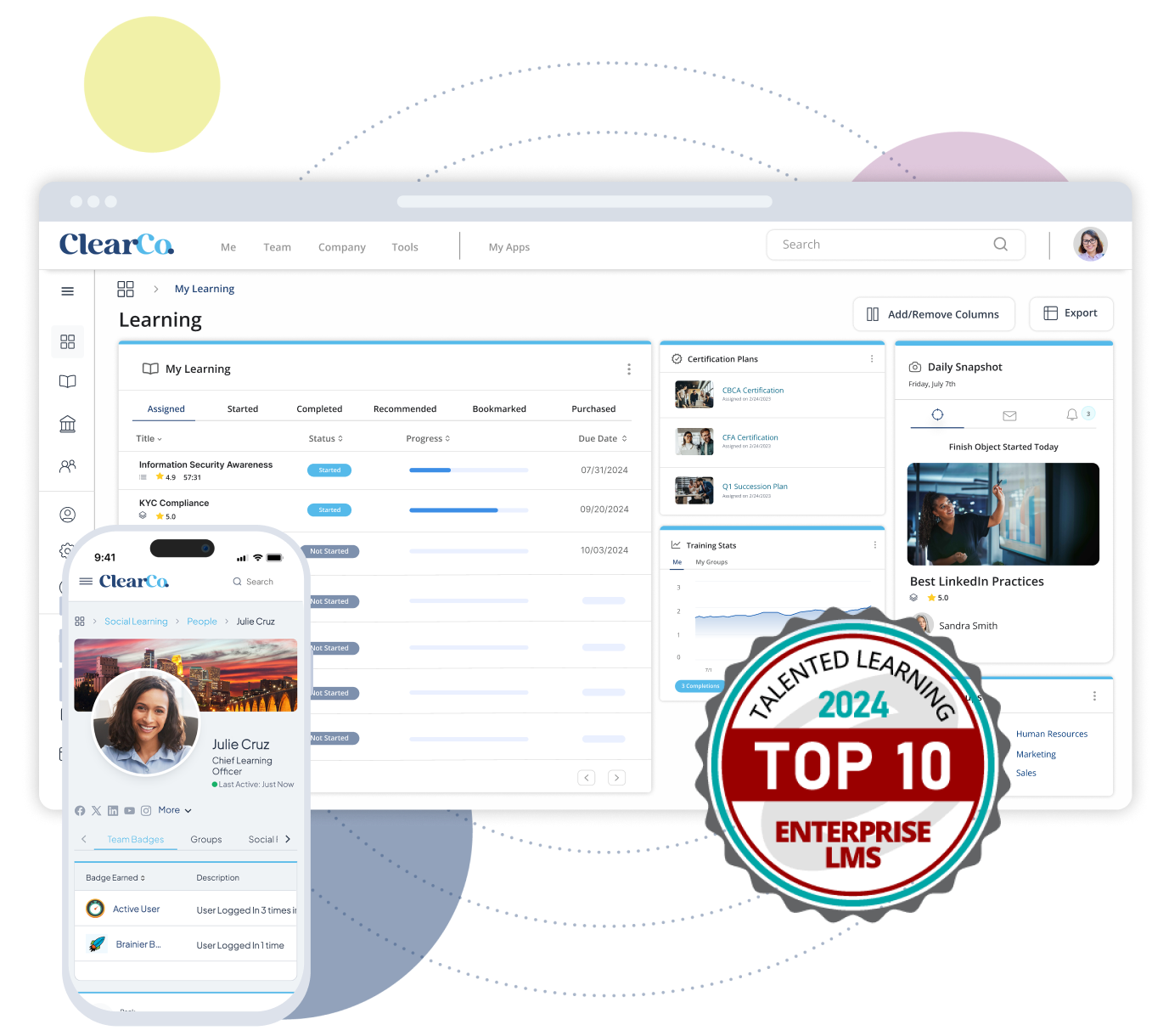Is artificial intelligence (AI) part of your workday yet? It’s reshaping many of our workflows, reducing processes from hours — even days — to seconds, and providing insights that would otherwise be hard to uncover. That includes those of us in HR and learning and development (L&D), where AI is starting to change how we train, upskill, and support employees.
One global business reported a 15% increase in efficiency and a 20% increase in productivity after using a learning management system (LMS) with AI. With the right system, AI can automate time-consuming admin tasks, deliver personalized learning paths, and connect employee development to business goals in ways that weren’t possible before.
Take a closer look at how LMS platforms use AI, which features matter most, and how AI helps HR and L&D teams develop more effective training and development programs for today’s workforce.
What Is LMS AI?
Traditional LMS solutions are excellent tools for creating, organizing, delivering, and tracking employee training and development programs. AI-powered learning software adds another layer of functionality, making these systems smarter and more strategic tools for L&D.
With AI, your LMS takes manual, time-consuming tasks off your plate — like assigning training, tracking progress, and analyzing outcomes — and handles them intelligently and at scale. On top of that, LMS AI can analyze employee data, recommend personalized learning paths, and even predict the skills your business will need in the future based on performance trends.
AI uses algorithms to recognize patterns and make suggestions tailored to each learner. For example, an AI-powered LMS might recommend training modules based on an employee’s role, goals, past progress, or upcoming projects. It can also surface content that’s highly rated by similar learners or flag when someone might be falling behind. That gives managers a chance to step in at the right moment to keep them engaged and on track with their development.
With automation and AI baked in, your LMS can handle more of the behind-the-scenes work than ever. That saves time for L&D and HR teams, freeing them up to focus on strategy, engagement, and fostering a learning environment that gets results.
5 Use Cases for LMS With AI
Wondering how you’d even use AI in L&D or in your LMS? L&D AI trends point to personalization, accessibility, and data-informed insights as the main reasons companies are seeking these solutions. Here’s a quick breakdown of five ways AI is already making learning platforms more practical and powerful.
Use Case #1: Tailored and Adaptive Learning Experiences
The key to getting your employees interested in learning and skill development — and keeping them interested — is personalization and agility. Training paths and progress aren’t linear or one-size-fits-all, and an AI-driven LMS can help you give employees the custom experience that drives real learning. How?
An AI LMS analyzes how your learners behave, including course completion rates, assessment scores, and engagement patterns. It combines those findings with information about each person’s role, goals, and performance data to suggest the most relevant modules and dynamically adjust lesson sequences and difficulty levels.
Combined with the ability to identify where learners might be struggling and suggest helpful materials or challenges, this level of customization helps you improve learning outcomes like never before.
Use Case #2: Better Accessibility
With LMS AI capabilities, training a diverse global team is possible. AI tools can handle multilingual translation, text-to-speech conversions, and real-time captions without requiring extensive work from your team or hiring an outside party. This ensures every employee can access course content in their preferred language or format, making learning a more inclusive experience for all.
20+ Questions To Start Your LMS Search
Get our list of questions to ask SaaS vendors as you search for the best-fit LMS.
Use Case #3: Automated Content Creation and Curation
Course creation and building learning paths are important but time-consuming activities that can end up becoming the main focus of your L&D team. But when you use an LMS with generative AI, you can create courses and map out learning paths in record time. The systems leverage generative AI as an authoring tool to create course summaries, quizzes, and even full modules in minutes.
With generative AI, your L&D team can also sift through existing articles, videos, and external resources to turn them into coherent learning paths based on learner profiles and business priorities.
Use Case #4: AI-Powered Virtual Tutors & Chatbots
Avoid confused learners and an L&D team tied up answering FAQs. An LMS with an embedded virtual assistant can provide employees with instant, context-specific feedback, guide them through tricky modules, and answer queries on the spot. That lightens the load for your team and inspires confidence in your learners.
Use Case #5: Advanced Analytics and Predictive Insights
Measuring standard course completion rates is old hat for LMS — and ultimately, only tells part of the story. AI dashboards don’t just track progress; they can predict it. An LMS with AI assists with identifying employees who are struggling with their learning paths and suggesting ways to intervene. Your L&D leaders can use insights to measure ROI, tweak training strategies, and ensure learning outcomes line up with business goals.
Key Features To Consider In an LMS With AI
Now that you know some of the ways an LMS with AI enhances learning experiences, it’s important to get familiar with the features to look for when you’re ready to implement. These are just a few of the top AI LMS features you’ll want to consider:
- Customization: With AI analyzing learner behavior and preferences, every employee gets the training they need, when they need it.
- Advanced Analytics: Intuitive dashboards provide predictive insights and skills gap analysis, helping you make informed decisions.
- Automated Workflows: From course creation to learner reminders, automation should simplify administrative tasks so your L&D team can focus on strategy, not busywork.
- Real-Time Support Tools: Keep learners on track while reducing the demand on instructors and L&D teams with AI tutors and chatbots that provide instant feedback and guidance
- Gamification and Engagement Tools: Features like AI-driven challenges, rewards, and leaderboards keep learners motivated and invested in their training.
- Accessibility and Localization: You want an LMS that includes features like AI-enabled translation and real-time captions to accommodate everyone in your workforce.
Take the next step toward finding the perfect AI-driven LMS — download our list of 20+ questions to ask vendors during your search.


